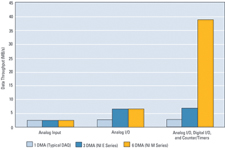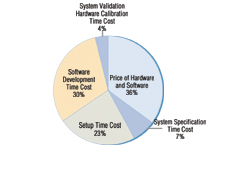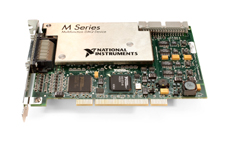Raising the Bar for Data Acquisition
Seven trends chart the course for the future of plug-in DA.
September 1, 2004
By Craig Anderson
I recently helped a “PC-challenged” friend format his hard drive and install an operating system. While typing commands at the prompt, I flashed back to when my monochrome Zenith monitor, text-based operating system with 64K of RAM were “all I will ever need.” Time and technology have proven otherwise. In the last 20 years, processing power, bus speeds, storage technology, and software have accelerated the desktop PC to a prominent position in almost every industry and application imaginable. Not least of these applications is the development of data acquisition (DA) and control systems.
Although it deserves respect, Mr. Moore's law cannot monopolize credit for the PC's success in DA systems. Advances in plug-in DA devices also are producing improvements in automated test, control, and sensor measurement applications. One example I have seen first hand occurred while working as an engineer on National Instruments's (NI) M Series. This article discusses seven trends marking the course for the future of plug-in DA devices and specifically discusses how NI's M Series of DA devices rewrites the rules for data acquisition, setting a new bar for what customers can expect out of DA (see the sidebar, below).
| So What Is the M Series?
Last month at its annual NIWeek conference in Austin, TX, National Instruments announced its new M Series data acquisition (DA) line, calling this 20-unit family its next generation of multifunction DA products. The company says that M Series devices offer breakthrough levels of accuracy and performance at lower costs—30 percent or more per I/O channel. The company adds that the M Series offers faster sampling rates, more I/O channels, and a broad set of expanded features previously not available in multifunction DA devices. M Series devices incorporate a number of technologies that combine to reduce overall systems cost. For example, the M Series is based on NI's newly designed NI-STC 2 system controller chip, which consolidates several discrete chips into a single ASIC (application-specific integrated circuit), providing greater performance in a smaller space. This synchronization and timing controller allows up to six operations to execute simultaneously at throughput rates up to five times faster than previous DA devices. Right: National Instruments's new M Series is made up of 20 multifunction data acquisition devices.Additionally, the M Series's NI-PGIA 2 programmable gain instrumentation amplifier (PGIA) reduces settling time to ensure accurate measurements even at the fastest scanning rates. Further, the M Series offers calibration at every input range. This, in turn, is said to improve measurement accuracy up to five times. The M Series DA devices offer up to thirty-two 18-bit analog input channels, four 16-bit analog outputs, two 32-bit counter/timers, and 48 digital I/O lines. Engineers can use the new devices to hardware-time up to 32 of the digital lines up to 10 MHz. Each M Series multifunction device includes NI-DAQmx measurement services driver software, which delivers easy configuration and a flexible programming interface for NI LabVIEW, Visual Studio .NET, and NI LabWindows/CVI. Individual unit pricing begins at $375. Complete details can be found on National Instruments's website. —DE Editors |
Trend #1: More I/O on Each Device
Not all trends in the desktop PC industry are advantageous to DA system development. For example, some computers now ship with fewer or half-height PCI slots, effectively decreasing the amount of space available for plug-in DA devices. These trends increase the importance of having analog input, analog output, digital I/O, and counter/timer functionality on a single device.To support a given channel count and provide the same functionality, modern applications require more I/O channels and types on each device.
Trend #2: Increased Data Throughput
As the number of channels and functions on a device increases, the potential for bottlenecking or errors due to data handling and transfer increases. Many plug-in DA devices are limited by the rate at which they transfer data to PC memory. Modern DA devices include onboard direct memory access (DMA) channels, which send data at high speeds directly from the device to PC memory without processor involvement. DA devices that execute more operations than available DMA channels require interrupt request lines (IRQs). As data transfer rates increase and more operations are simultaneously performed, these IRQs begin to monopolize PC processor time, causing system slowdowns and buffer overflow errors.
Figure 1 (below, right) illustrates the high-data throughput that is possible with multiple I/O operations exercising multiple DMA channels. The new M Series DA devices can control six DMA channels for the execution of six operations simultaneously,  mitigating the risks of losing data or encountering data transfer errors.
mitigating the risks of losing data or encountering data transfer errors.
Trend #3: Improved Calibration
Electronic components, such as analog-to-digital converters (ADCs), are characterized by nonlinearities and drift due to time and temperature. To compensate and ensure accurate measurements, devices must be calibrated.
Legacy devices use an onboard 5V precision voltage reference to perform a two-point self-calibration at 5V and 0V ground to generate a straight-line approximation of the ADC linearity. When subsequently measuring voltage levels away from the 0V and 5V calibration points, the linear approximation from calibration may produce significant inaccuracies.
Next-generation devices, such as the National Instruments M Series, can self-calibrate over all input ranges. This results in an accurate polynomial correction curve rather than a linear approximation. This calibration methodology improves measurement accuracy by as much as 500 percent.
Trend #4: Decreased Settling Time
Have you ever stared at a television too long then glanced at an adjacent wall only to see a resemblance of the TV? This happens when your retinas have not quickly settled and can't return an accurate image of the adjacent wall to your brain.
DA devices have a similar problem. When the ADC multiplexes between two channels with large voltage differences and the signals are digitized too quickly, the measurement is inaccurate. With the exception of simultaneous sampling plug-in DA devices that have a dedicated ADC for each channel, an ADC must wait and settle down before it can take the next measurement accurately. Design advances providing faster settling times increase the DA scan rates and maintain accuracy.
Trend #5: More than Just a Driver 
Most device drivers successfully expose hardware functionality. But not all device drivers are created equal. According to a survey performed by National Instruments, engineers typically spend more than 50 percent of their total system costs on setup and development (see Figure 2, right). Measurement services, such as data logging programs and code generation tools, can reduce these development costs. Additionally, every driver should include software that makes it easy to control, manage, test, and calibrate devices.
Trend #6: Adoption of New Bus Standards
In the early 1990s, Intel's PCI computer bus earned wide industry acceptance and quickly became the standard. The maximum transfer limit of 132MBps promised higher throughput, and DA devices began capitalizing on this benefit.
Since USB is excellent for portable applications and easy device setup, the market is flooded with USB DA products. The list continues with PXI (PCI eXtensions for Instrumentation) for advanced timing, triggering, and synchronization; and Ethernet is used for networking distributed devices. New standards, including PCI Express, are showing promise. Soon, DA devices will capitalize on these advances.
Trend #7: The Internet Encyclopedia
A popular home improvement website offers a “Know-How” section that provides instructions and training schedules for do-it-yourselfers. Engineers and scientists, like do-it-yourselfers, want a how-to encyclopedia, and the majority of them turn to the Web for research, system specification, and development help. Online documentation easily helps exercise the flexibility of DA devices. As Internet technologies advance and connectivity increases, online tutorials, events, software evaluations, and technical help will become more valuable.
Advances Loom
To conclude, the PC industry leads many advances in data acquisition applications; however, DA devices are also improving independently. It is vital that customers demand designs that decrease settling times, improve calibration accuracy, and provide more I/O per device while enabling simultaneous operations without data loss.
The M Series DA devices pave the way for the next-generation of DA by incorporating all of these improvements and leveraging these industry trends. Additionally, timesaving software included with drivers and online resources will continue to increase productivity. New generations of plug-in DA devices coupled with desktop PC advances will promise to improve the speed of discovery for scientists and engineers worldwide.
Craig Anderson is a data acquisition systems engineer for National Instruments in Austin, TX. You can contact him about this article by sending e-mail c/o Desktop Engineering Feedback.
Product and Company Information
M Series Data Acquisition Devices
National Instruments
Austin, TX
ni.com
Enter Reader Service 181 on deskeng.com
Subscribe to our FREE magazine, FREE email newsletters or both!
About the Author
DE’s editors contribute news and new product announcements to Digital Engineering.
Press releases may be sent to them via [email protected].







